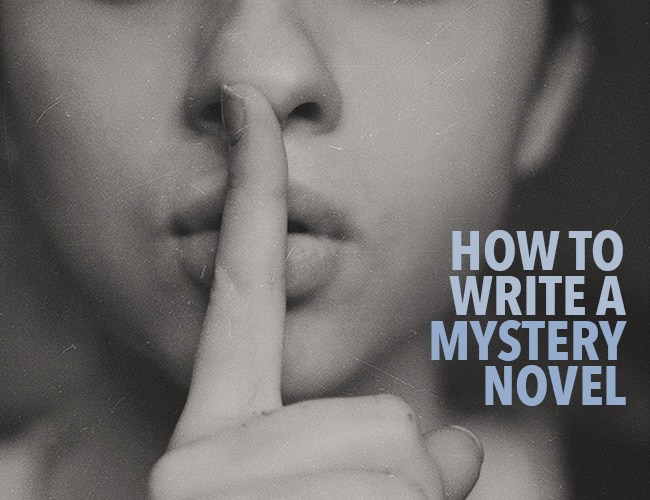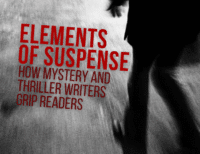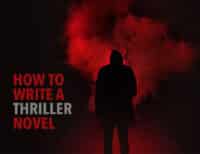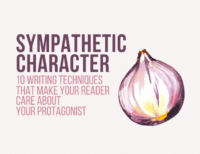Mystery stories appeal to our need to survive by figuring out the puzzles, problems, and sometimes crimes that affect our lives (or those of a character we care about).
Today we continue our series on how to write each of the nine types of stories with how to write a mystery novel. Let's dive into how to tell a great mystery!

The best preparation for writing a mystery novel is to be a mystery reader. You need to be able to rely on reflexes developed after years of reading experience. And you’ll need the devotion of a true fan to get you through the rough spots.
I’ll be honest—there’s a heck of a lot that goes into writing a mystery novel whether it's a murder mystery or another sub-genre. However, if you put in the time and effort to make it happen, you’ll get a heck of a lot out of it on the other end. So, let’s get started.
What makes a mystery a mystery?
If you want to know how to write a mystery novel, you have to understand the conventions of the mystery genre; you have to know what makes a mystery a mystery. Dean Wesley Smith, one of the most prolific mystery writers of our day, defines a mystery as a story that involves a crime or puzzle to be solved, and it must be resolved by story’s end.
“Do not ignore this convention,” he warns, “unless you want to piss off your readers.”
I can attest to this, from a reader’s perspective. My own fault, I’m sure, but I read Donna Tartt’s The Little Friend, thinking I was reading a mystery, and nearly flung the book against a wall when I reached the end, mystery unsolved.
People who read mysteries like to solve puzzles and anticipate a resolution at the end. But reader expectations go far beyond that. Readers want to identify with the hero, to experience the thrill of the hunt and the satisfaction of seeing the perpetrator punished.
Fulfilling reader expectation is of paramount importance in writing a novel in any genre, but it’s crucial to writing a mystery. The mystery genre attracts a massive following, accounting for roughly thirty-three percent of fiction sales in the English language. If you can please even a portion of that audience, you’re setting yourself up for success in the mystery field.
Which type of mystery best suits your writing style?
Many sub-genres nestle under the mystery umbrella, and different writers are suited to different types of mystery.
Cozies, for instance, require a great deal of setting and character description, maintaining a slow pace while keeping it interesting. Cozies are gentle, characterized by a bloodless crime, often featuring a victim with few emotional ties to any of the characters, and the violence takes place off-stage.
Cozy writers must be able to produce upwards of 60,000 words, without a lot of action, and still make it engaging. Focus is on the amateur sleuth (and the community), rather than the crime.
Police procedurals, as well as medical and legal mysteries, require extensive specialized knowledge. These are suited for professionals in these fields, detail-oriented writers who love the nitty gritty of procedure. Readers will chew you up and spit you out if you get it wrong, and light research is not enough to get you through.
This type of writer should also be good at building teams for their characters, as much of the clue gathering and analysis will fall to a group, each member contributing to the solution of the crime.
In Private Eye/Noir novels and detective fiction, readers expect a really interesting, believable main character. The PI will have interactions with police, and those must be realistic, so knowledge or research in this area is necessary, but not to the exacting degree required for police procedurals.
Well-known examples of this type of detective fiction include Sir Arthur Conan Doyle's Sherlcok Holmes and Agatha Christie's Poirot stories.
The protagonist often makes a living solving crimes, doing background investigations, and such. Modern PI’s are crack computer experts, so a background in IT or related fields would be helpful to a writer who wants to tackle a PI novel. If the tone of the novel is dark, gritty, particularly bloody, or brazenly urban, it’s probably a noir.
There are also historical mysteries which combine a setting from the past with the usual puzzle or murder inherent in a mystery (see Deanna Raybourne's Veronica Speedwell series). You also have paranormal mysteries, those that include some element of the supernatural (like those by Charlaine Harris). Historical settings and supernatural elements can be combined with any of the subgenera above as well.
And then there’s suspense—but that’s a subject for another day.
Know the tropes
Mystery, like all genres, is rife with tropes, common themes or devices readers recognize and understand by implication. Some examples are “the butler did it” or “locked room mystery.” While these may strike you as trite, most of them are time-honored and beloved by mystery fans.
The trick is not to avoid them, but to innovate them, finding fresh ways to approach them so that readers get the best of both worlds—a comfortable familiarity and a rush of surprise.
Have a plan
I’ve heard there are mystery writers who write without an outline, striking boldly into the dark and trusting that all the threads that go into weaving a mystery will align in miraculous fashion. How they accomplish such a thing is the real mystery. I suspect there are more closet plotters than we’ve been led to believe or they spend an inordinate amount of time revising.
Knowing the end from the beginning is particularly important when crafting a mystery, so if you’re adept at using an outline, that’s a big step forward in completing your novel. And crafting the outline for a mystery novel can be a boatload of fun. It may even be my favorite part.
An outline should never be a confining box, but more like a scaffold to support you while you construct the story. I’ll cover outlining in more depth in another post. For now, let’s take a quick look at four suggestions from Lester Dent, creator of the Doc Savage series. Some say he was a hack, but for a hack, he sure got a lot of things right.
When writing a mystery, he suggests you consider these four areas:
- Murder method. Try to find a fresh slant on what’s been done before. I did a quick Google search for innovative murder methods and, as you might imagine, the resulting list was scary long. Explore at your own risk. Another source you might consider for generating unusual ideas is the Darwin Awards.
- The antagonist’s goal. What is the bad guy ultimately after? Dent describes it as treasure of some sort, literal or metaphorical. Even a serial killer (or maybe especially a serial killer!) has some larger goal in mind, whether it is respect, revenge, justice, restitution, or some other goal.
- The setting for the story should be determined by the crime and the villain. Once you have those nailed down, the setting should follow.
- The hero’s motivation. Another way of looking at this is to ask, “What’s at stake?” What will the hero gain if he reaches his goal? What will he lose if he is defeated?
One more quick suggestion for outlining, this from Scott Meredith and Algis Budrys. Formulate a…
- Character
- In a setting
- With a problem
- Put your protagonist through a series of try/fail cycles while solving the crime, escalating the stakes with each cycle
- The last try/fail cycle is the most perilous and challenging of all and is followed either by the hero’s success in catching the murderer and bringing him to justice, or his ultimate failure
Remember, in a mystery, the puzzle must be solved by the end. So, if you decide to have a tragic or ironic ending with the hero’s failure, you still have to provide a solution to the puzzle and satisfy your mystery savvy readers.
If you use this type of outlining, it may be helpful to expand those try/fail cycles to include a list of clues, crime scenes, potential suspects, false clues, wrong suspects, and maybe the crucial clue that helps the sleuth put it all together.
A mystery requires cause and effect relationships. When a diligent sleuth is presented with a potential clue, they go check it out. They work from a list of suspects and try to eliminate as many as they can by establishing alibis, means, motive, and opportunity.
Make sure that as you plan or revise your mystery stories that you make those cause and effect relationships clear, as well as deepen your character development. You want your readers to be invested in the sleuth and the puzzle.
A few mystery tips
Once you've chosen your sub-genre, studied the tropes, and created your plan, you're ready to write. Here are a few more things to keep in mind when writing a mystery.
Most mysteries open with the crime. It’s a good way to grab reader interest right up front. Cozies are an exception to this rule. If you’re writing a cozy, you need to spend a couple thousand words grounding your reader in the setting, with the character, before you allow the crime to intrude on that world.
Just because you have an outline doesn’t mean you have to write from word one to the end. Writers are unstuck in time. We can move freely through the landscape of our novel, write the climactic scene first, then go back and make sure we set it up right in earlier scenes. Don’t feel like you have to plod forward on a rigid track.
You have to be fair to the reader, putting the clues in plain sight. That said, there are ways to obscure bits of information so readers don’t really see them.
One of the best ways is to use a list. Readers absorb the first three items on a list, and maybe the last one. Anything that occurs between number three and the last item blurs out and virtually disappears from the reader’s memory.
You can make the amateur sleuth focus on one clue based on what they know so far, leaving the major clue or biggest clue behind to resurface later.
It takes time for a reader to get through a full-length novel. You can practically give the reader the solution up front and by the time they reach the middle of the book, they will have forgotten it.
So don’t be afraid to lay out what the reader needs to know. As long as you don’t surround it with fanfare, it will fade out until the end when the readers thinks, “Oh yeah, I remember now.”
This is not to say that mystery readers are dumb. Not by any stretch of the imagination is that the case. My biggest challenge in writing mysteries has been to find the balance between holding back too much and giving it all away.
The award-winning mystery writer Kristine Kathryn Rusch advises never to hold back information from the reader. Give it all away, she says, but do it skillfully. Experience has proved her right.
Keep learning
How to write a mystery novel is a huge subject, and goes far beyond the scope of this article. Read books in the mystery genre, but also read and study widely from those who have written good mysteries. For more information, here are a few good resources:
- Writing The Modern Mystery, by Barbara Norville
- How To Write A Damn Good Mystery, by James N. Frey
- Writing Mysteries: A Handbook by The Mystery Writers of America, edited by Sue Grafton
- Writing Mysteries, Online Workshop by Dean Wesley Smith
Keep studying and learning your genre. But don't let study keep you from writing. The best practice comes through writing, so if you want to write a mystery novel, give it a go!
What are your favorite types of mysteries and why? What tropes or other common elements of mysteries intrigue or repel you? Share something about it in the comments.
PRACTICE
Consider your writing style and choose a mystery sub-genre you think is a good fit: cozy, police/medical/legal procedural, private eye/noir, or suspense. Write the opening scene for such a mystery, making sure you respect the conventions and reader expectations.
Write for fifteen minutes. When finished, share your practice in the Pro Practice Workshop, and leave feedback for a few other writers. Not a member? Join us.







What if one day you wake up and you see a dead body on the floor with a hand outstretched and grabbing your bed sheets? What if you never heard any sounds that night, but slept peacefully? What if, by the time you realize what’s going on, the police already bursts through the door and handcuffs you?
Then there’s only one way out. To prove you’re innocent. But how?
Those were all questions running through the mind of Dr. Brian Walker, who was now sitting at the table with two skilled detectives, trying to wrap his mind around the whole thing. Sweat trickled down his forehead, the light bulb was too bright, the room too cold. What is it with detectives and their weird settings? Can’t they discuss a murder on a cozy couch with floral wallpaper and some soft drinks fizzing on a glass table?
Dr. Brian tried his best to answer the questions, but he could clearly see the conviction in their eyes, like a stamp with the words ‘’Guilty’’ imprinted in their irises.
‘’ And how you’re going to prove it?’’ One of the detectives asked, by far the most peculiar he’d ever seen. He looked like a teenage punkster and at first, he thought he was another suspect in the case, until the man placed his badge on the table. The coffee was steaming, but with no clues. Either that or he wasn’t psychic enough to read steams.
A dead body, a groggy doctor. The man in his room was stabbed only once, through the stomach. There was a pool of blood by the bed, but no sign of a struggle. Both the dead man and Dr. Brain had no bruises or any other possible marks.
‘’ I’m trying to understand what kind of man you are. Stabbing someone in your own house and then going to sleep as if nothing happened. Good thing the gardener saw the dead body through the window and called the police. ‘’ The other detective said, carefully brushing his long hair. What kind of department had hired people looking like TV Stars in their twenties?
‘’ I don’t even have a gardener.’’ The doctor remarked, furrowing his brows.
‘’ What you didn’t have was the opportunity to get rid of the body. You must be a real psycho to think you’d wake up early and get rid of the body before anyone saw it. ‘’ At that point, he didn’t know who said what. He stopped looking at the two men and focused on his feet, on the floor shaking underneath. The whole world was shaking. Everything seemed like part of a dream. It was like someone woke up one day and decided to die in his house just to spite him.